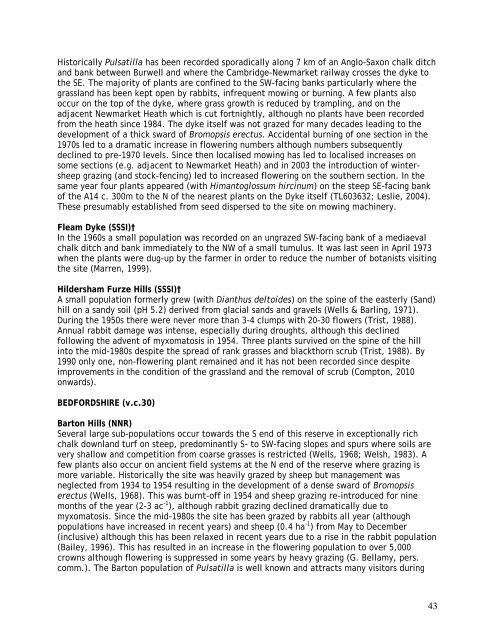Pulsatilla vulgaris (L.) Mill. - Plantlife
Pulsatilla vulgaris (L.) Mill. - Plantlife
Pulsatilla vulgaris (L.) Mill. - Plantlife
Create successful ePaper yourself
Turn your PDF publications into a flip-book with our unique Google optimized e-Paper software.
Historically <strong>Pulsatilla</strong> has been recorded sporadically along 7 km of an Anglo-Saxon chalk ditch<br />
and bank between Burwell and where the Cambridge-Newmarket railway crosses the dyke to<br />
the SE. The majority of plants are confined to the SW-facing banks particularly where the<br />
grassland has been kept open by rabbits, infrequent mowing or burning. A few plants also<br />
occur on the top of the dyke, where grass growth is reduced by trampling, and on the<br />
adjacent Newmarket Heath which is cut fortnightly, although no plants have been recorded<br />
from the heath since 1984. The dyke itself was not grazed for many decades leading to the<br />
development of a thick sward of Bromopsis erectus. Accidental burning of one section in the<br />
1970s led to a dramatic increase in flowering numbers although numbers subsequently<br />
declined to pre-1970 levels. Since then localised mowing has led to localised increases on<br />
some sections (e.g. adjacent to Newmarket Heath) and in 2003 the introduction of wintersheep<br />
grazing (and stock-fencing) led to increased flowering on the southern section. In the<br />
same year four plants appeared (with Himantoglossum hircinum) on the steep SE-facing bank<br />
of the A14 c. 300m to the N of the nearest plants on the Dyke itself (TL603632; Leslie, 2004).<br />
These presumably established from seed dispersed to the site on mowing machinery.<br />
Fleam Dyke (SSSI)†<br />
In the 1960s a small population was recorded on an ungrazed SW-facing bank of a mediaeval<br />
chalk ditch and bank immediately to the NW of a small tumulus. It was last seen in April 1973<br />
when the plants were dug-up by the farmer in order to reduce the number of botanists visiting<br />
the site (Marren, 1999).<br />
Hildersham Furze Hills (SSSI)†<br />
A small population formerly grew (with Dianthus deltoides) on the spine of the easterly (Sand)<br />
hill on a sandy soil (pH 5.2) derived from glacial sands and gravels (Wells & Barling, 1971).<br />
During the 1950s there were never more than 3-4 clumps with 20-30 flowers (Trist, 1988).<br />
Annual rabbit damage was intense, especially during droughts, although this declined<br />
following the advent of myxomatosis in 1954. Three plants survived on the spine of the hill<br />
into the mid-1980s despite the spread of rank grasses and blackthorn scrub (Trist, 1988). By<br />
1990 only one, non-flowering plant remained and it has not been recorded since despite<br />
improvements in the condition of the grassland and the removal of scrub (Compton, 2010<br />
onwards).<br />
BEDFORDSHIRE (v.c.30)<br />
Barton Hills (NNR)<br />
Several large sub-populations occur towards the S end of this reserve in exceptionally rich<br />
chalk downland turf on steep, predominantly S- to SW-facing slopes and spurs where soils are<br />
very shallow and competition from coarse grasses is restricted (Wells, 1968; Welsh, 1983). A<br />
few plants also occur on ancient field systems at the N end of the reserve where grazing is<br />
more variable. Historically the site was heavily grazed by sheep but management was<br />
neglected from 1934 to 1954 resulting in the development of a dense sward of Bromopsis<br />
erectus (Wells, 1968). This was burnt-off in 1954 and sheep grazing re-introduced for nine<br />
months of the year (2-3 ac -1 ), although rabbit grazing declined dramatically due to<br />
myxomatosis. Since the mid-1980s the site has been grazed by rabbits all year (although<br />
populations have increased in recent years) and sheep (0.4 ha -1 ) from May to December<br />
(inclusive) although this has been relaxed in recent years due to a rise in the rabbit population<br />
(Bailey, 1996). This has resulted in an increase in the flowering population to over 5,000<br />
crowns although flowering is suppressed in some years by heavy grazing (G. Bellamy, pers.<br />
comm.). The Barton population of <strong>Pulsatilla</strong> is well known and attracts many visitors during<br />
43

















